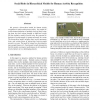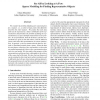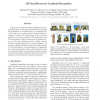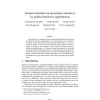CVPR
2012
IEEE
12 years 9 months ago
2012
IEEE
We present a hierarchical model for human activity recognition in entire multi-person scenes. Our model describes human behaviour at multiple levels of detail, ranging from low-le...
113
click to vote
CVPR
2012
IEEE
12 years 9 months ago
2012
IEEE
We consider the problem of finding a few representatives for a dataset, i.e., a subset of data points that efficiently describes the entire dataset. We assume that each data poi...
CVPR
2012
IEEE
12 years 9 months ago
2012
IEEE
Recently sparse representation has been applied to visual tracker by modeling the target appearance using a sparse approximation over a template set, which leads to the so-called ...
CVPR
2012
IEEE
12 years 9 months ago
2012
IEEE
In this paper, we study the problem of landmark recognition and propose to leverage 3D visual phrases to improve the performance. A 3D visual phrase is a triangular facet on the s...
CVPR
2012
IEEE
12 years 9 months ago
2012
IEEE
Reconstructing realistic 3D hair geometry is challenging due to omnipresent occlusions, complex discontinuities and specular appearance. To address these challenges, we propose a ...
CVPR
2012
IEEE
12 years 9 months ago
2012
IEEE
The k-NN graph has played a central role in increasingly popular data-driven techniques for various learning and vision tasks; yet, finding an efficient and effective way to con...
CVPR
2012
IEEE
12 years 9 months ago
2012
IEEE
This paper is aimed at calibrating the relative posture and position, i.e. extrinsic parameters, of a stationary camera against a 3D reference object which is not directly visible...
CVPR
2012
IEEE
12 years 9 months ago
2012
IEEE
We describe an online approach to learn non-linear motion patterns and robust appearance models for multi-target tracking in a tracklet association framework. Unlike most previous...
CVPR
2012
IEEE
12 years 9 months ago
2012
IEEE
In this paper, we address the task of tracking groups of people in surveillance scenarios. This is a major challenge in computer vision, since groups are structured entities, subj...
CVPR
2012
IEEE
12 years 9 months ago
2012
IEEE
Watershed cuts are among the fastest segmentation algorithms and therefore well suited for interactive segmentation of very large 3D data sets. To minimize the number of user inte...




